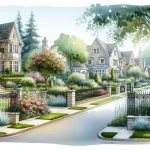The Garden District of New Orleans showcases an impressive array of 19th-century architectural grandeur. Developed between 1832 and 1900, this historic neighborhood features a diverse collection of architectural styles, reflecting the city’s rich cultural heritage. From stately Greek Revival and ornate Italianate to charming Victorian and Creole cottages, the well-preserved mansions and lush gardens have captivated visitors for nearly two centuries.
In This Article
TL;DR
- The neighborhood boasts a remarkable blend of architectural styles from the 19th century, including Greek Revival, Italianate, Victorian, Creole cottages, and shotgun houses.
- Many historic mansions have been meticulously preserved, offering guided tours that transport visitors to a bygone era of elegance and grandeur.
- The picturesque charm of the Garden District is enhanced by its lush gardens and parks, creating a serene oasis within the vibrant city.
Architectural Styles
The Garden District is a veritable museum of 19th-century architectural styles. Greek Revival, popular in the 1830s and 1840s, is characterized by its symmetrical façades, columns, and pediments, as seen in the Women’s Guild of the New Orleans Opera Association house at 2504 Prytania St. Italianate style, which gained prominence in the 1850s and 1860s, features elaborate bracketed cornices, tall narrow windows, and ornate moldings, exemplified by the Robinson House at 1415 Third St.
Victorian architecture, with its intricate gingerbread trim, turrets, and asymmetrical designs, became fashionable in the late 19th century. The Briggs-Staub House at 2605 Prytania St is a prime example of this style. Creole cottages and shotgun houses, which were popular among working-class families, are also found throughout the Garden District, adding to its architectural diversity.
Notable Mansions
Colonel Short’s Villa
The Garden District is home to numerous historic mansions that have been carefully preserved and restored. Colonel Short’s Villa at 1448 Fourth St, known for its intricate cast-iron cornstalk fence, is a stunning example of Italianate architecture.
Briggs-Staub House
The Briggs-Staub House at 2605 Prytania St, built in 1849, features a mix of Greek Revival and Italianate elements.
Women’s Guild of the New Orleans Opera Association
The Women’s Guild of the New Orleans Opera Association, located at 2504 Prytania St, is a Greek Revival mansion that now serves as a cultural center.
Robinson House
The Robinson House at 1415 Third St, an Italianate mansion built in 1859, is another architectural gem.
Musson-Bell House
The Musson-Bell House at 1331 First St, built in 1853, showcases a blend of Greek Revival and Italianate styles.
Historic Landmarks
In addition to its magnificent mansions, the Garden District is home to several historic landmarks. Lafayette Cemetery No. 1, established in 1833, is one of the oldest and most iconic cemeteries in New Orleans. Commander’s Palace, a renowned restaurant housed in a stunning Victorian building, has been a Garden District institution since 1893.
The George Washington Cable House, where the famous author lived and wrote, is now a museum dedicated to his life and work. Anshe Sfard Synagogue, built in 1925, is a beautiful example of Moorish Revival architecture. Toby’s Corner, at the intersection of Prytania and First Streets, is a beloved neighborhood gathering spot.
Influential Architects
The Garden District’s architectural splendor is a testament to the skill and vision of its architects. Henry Howard, one of the most prolific architects of the 19th century, designed numerous mansions in the neighborhood, including the Briggs-Staub House and the Women’s Guild of the New Orleans Opera Association building.
James Gallier Sr. and his son James Gallier Jr. were also prominent architects who left their mark on the Garden District. The father-son duo designed several notable mansions, including the Robinson House. Lewis E. Reynolds, known for his Italianate and Victorian designs, and Thomas Sully, who specialized in Greek Revival architecture, also contributed to the neighborhood’s architectural legacy.
Garden District Parks and Green Spaces
The Garden District’s lush parks and green spaces are an integral part of its charm. Coliseum Square, designed in 1850, features a central fountain and is surrounded by historic mansions. Clay Square, named after Henry Clay, is another picturesque park that serves as a gathering place for residents.
Annunciation Square, located on the site of a former plantation, is a popular spot for picnics and outdoor events. Leontine Park, a small pocket park on Leontine Street, provides a quiet respite from the city’s hustle and bustle.
Preservation Efforts
The Garden District’s architectural heritage is protected through various preservation efforts. The neighborhood was designated a National Historic Landmark in 1974, recognizing its significant contribution to American history and culture. Strict zoning laws and historic preservation regulations ensure that any renovations or new construction maintain the district’s architectural integrity.
The Preservation Resource Center of New Orleans and the Garden District Association work tirelessly to promote the preservation and restoration of the neighborhood’s historic buildings. These organizations offer resources, education, and advocacy to help property owners maintain their homes in a manner that respects the district’s architectural legacy.
Garden District Tours
One of the best ways to experience the Garden District’s architectural marvels is through a guided tour. Self-guided walking tours, using maps and brochures available at local bookstores and visitor centers, allow you to explore the neighborhood at your own pace. Guided tours led by local historians and preservation experts provide a more in-depth look at the district’s history and architecture.
Some popular tour companies include:
- Free Tours by Foot: Offers daily pay-what-you-wish walking tours of the Garden District. Tours depart from the Garden District Book Shop at 2727 Prytania St. Phone: (504) 356-9696
- Historic New Orleans Tours: Provides guided walking tours of the Garden District, focusing on its architecture, history, and famous residents. Tours depart from the corner of Prytania St. and Washington Ave. Phone: (504) 947-2120
- New Orleans Architecture Tours: Specializes in tours that highlight the city’s diverse architectural styles, including those found in the Garden District. Private tours available by appointment. Phone: (504) 975-5355
Many tours also highlight the Garden District’s connection to popular culture, including famous movies and TV shows filmed in the neighborhood, such as “Interview with the Vampire” and “American Horror Story.”
The Garden District’s architectural treasures, meticulously preserved through the efforts of its residents and local organizations, continue to enchant visitors from around the world. As you stroll along its oak-lined streets, admiring the intricate details of its mansions and the tranquility of its gardens, you’ll find yourself transported to a bygone era of elegance and grandeur. The Garden District remains a testament to New Orleans’ rich history and a shining example of architectural preservation at its finest.






